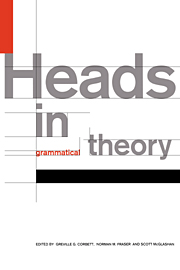Book contents
- Frontmatter
- Contents
- List of contributors
- 1 Introduction
- 2 The head of Russian numeral expressions
- 3 The phonology of heads in Haruai
- 4 Patterns of headedness
- 5 Head-hunting: on the trail of the nominal Janus
- 6 The headedness of noun phrases: slaying the nominal hydra
- 7 Head- versus dependent-marking: the case of the clause
- 8 Heads in discourse: structural versus functional centricity
- 9 Heads in Head-driven Phrase Structure Grammar
- 10 Heads and lexical semantics
- 11 Heads, parsing and word-order universals
- 12 Do we have heads in our minds?
- 13 Heads, bases and functors
- References
- Index
13 - Heads, bases and functors
Published online by Cambridge University Press: 23 February 2010
- Frontmatter
- Contents
- List of contributors
- 1 Introduction
- 2 The head of Russian numeral expressions
- 3 The phonology of heads in Haruai
- 4 Patterns of headedness
- 5 Head-hunting: on the trail of the nominal Janus
- 6 The headedness of noun phrases: slaying the nominal hydra
- 7 Head- versus dependent-marking: the case of the clause
- 8 Heads in discourse: structural versus functional centricity
- 9 Heads in Head-driven Phrase Structure Grammar
- 10 Heads and lexical semantics
- 11 Heads, parsing and word-order universals
- 12 Do we have heads in our minds?
- 13 Heads, bases and functors
- References
- Index
Summary
Introduction
This chapter argues that when syntacticians refer to heads, they are referring to one of at least three distinct notions, all of which have a place in the theory of syntax. It can thus be seen as a working out and refinement of the syntactic portions of Zwicky (1985), especially in response to the discussion by Hudson (1987).
My 1985 paper examined several situations in which the assignment of head or dependent status to some participant in a syntactic construction is unclear; for them, tests that pick out the head in straightforward cases like verb or preposition plus object {see penguins, about penguins) do not always make a unique assignment. Hudson (1987) attempted to show that a unique head could be picked out anyway, but at the cost of abandoning some tests and re-interpreting others. Still other syntacticians (for instance, Fenchel, 1989; Warner, 1989; Radford, this volume) have proposed that various problematic cases involve the assignment of head status to more than one participant in a construction, but again at a cost (complications in other parts of the description or other parts of the theory). With these latter authors, I propose to ‘have it both ways’, but not by assigning multiple head status, a step I reserve (see section 13.8) for quite a different set of phenomena.
Instead, what I want to say about heads is rather like what most syntacticians now say about subjects.
- Type
- Chapter
- Information
- Heads in Grammatical Theory , pp. 292 - 316Publisher: Cambridge University PressPrint publication year: 1993
- 15
- Cited by



